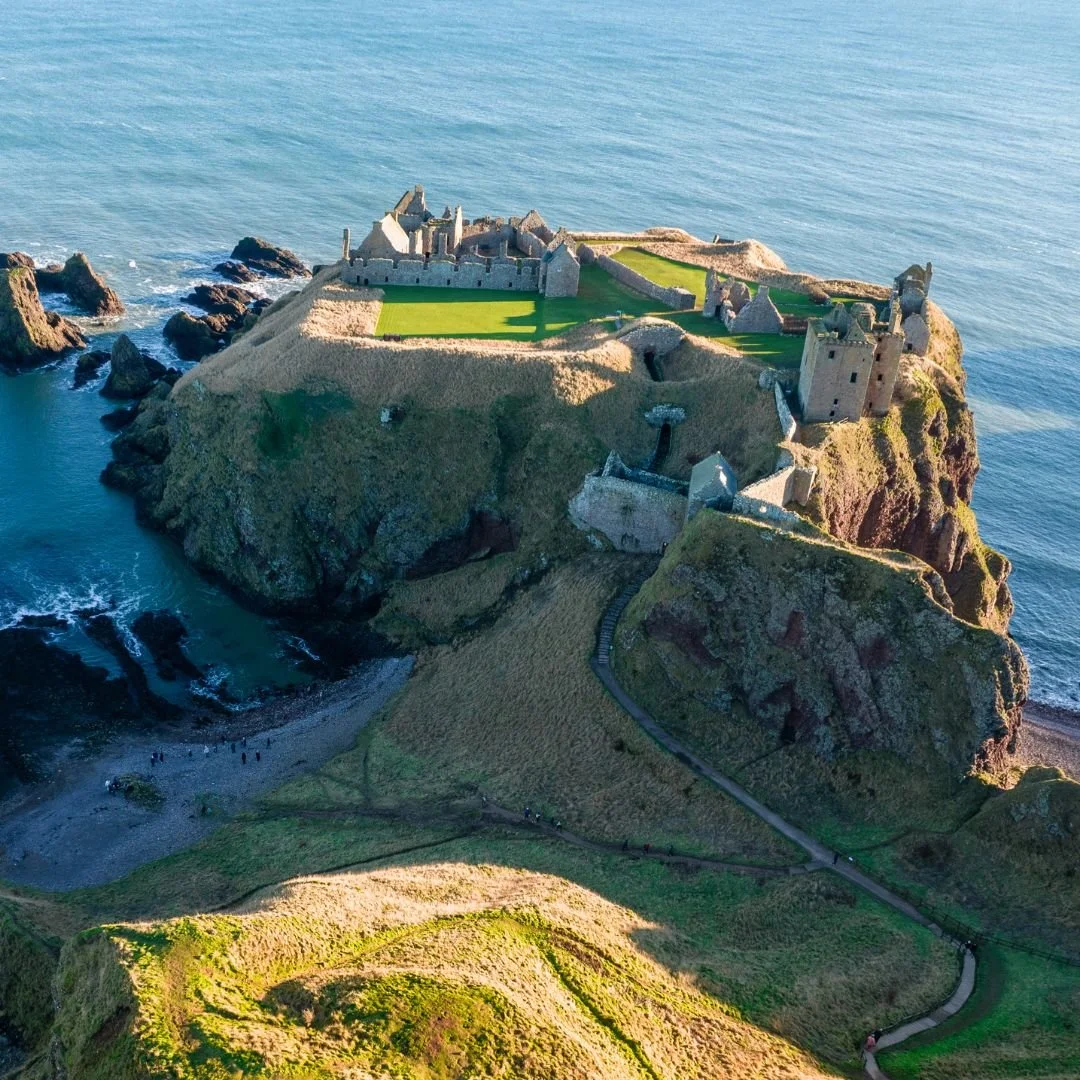Dunnottar Castle: Scotland’s Coastal Fortress
Perched atop a 160 foot rock and surrounded on three sides by the North Sea, Dunnottar Castle, Scotland was once an impregnable fortress.
This flat-topped, red sandstone island was once connected to the mainland by a natural causeway.
However, to protect the Medieval castle from attack, the natural pathway across the Fiddlehead was deliberately hacked away.
Instead, a new access route was cut into the cliffs - this plunging, narrow entrance route was designed to be a nightmare for any would-be attacker.
This is because of its twisting pathway, blind corners, and arrow-looped 26ft tunnel – which would have made it easy for archers to pick off incoming assailants.
Located near the town of Stonehaven in Aberdeenshire, Scotland, Dunnottar Castle boasts a history that dates back to the Early Middle Ages.
Its strategic position on the northeast coast rendered it a crucial stronghold throughout Scotland’s turbulent past.
The castle’s origins can be traced to the 7th century, although the structures visible today mostly stem from the 15th and 16th centuries.
Dunnottar witnessed numerous historical events, including Viking invasions, religious conflicts during the Reformation, and political upheavals during the Scottish Independence Wars.
In 1297, William Wallace lead the Scottish rebellion against the English invasion, and besieged Dunnottar Castle – presently held by English troops.
Terrified by the progress of Wallace’s troops, as many as 4,000 English soldiers holed themselves within the stone chapel inside Dunnottar Castle – naively believing that hiding out in a church would spare them from death.
They were, unfortunately, to meet a grisly end. Wallace’s army ransacked the castle and torched the church, burning alive those within.
Some, of course, managed to flee – but their only choice was to leap off the steep cliffs into the thrashing sea.
One of the most renowned episodes in Dunnottar Castle’s history is the ‘Whig’s Vault’ incident of 1685.
During this time, the castle served as a temporary prison for a group of Covenanters who resisted King Charles II's religious reforms.
Despite enduring harsh conditions and deprivation, these prisoners held onto their beliefs and refused to renounce their faith, becoming symbols of steadfastness and resilience.
Dunnottar is also well known as the place where the Honours of Scotland, the Scottish crown jewels, were hidden from Oliver Cromwell’s invading army in the 17th century.
The Honours were the most potent symbol of Scotland's monarchy and consisted of a court crown, a ceremonial sword, and a sceptre.
The Honours would normally have been returned to storage at Edinburgh Castle, but Oliver Cromwell seized Edinburgh, so the Honours (pictured below) were sent to Dunnottar Castle for safety.
Cromwell was determined to destroy the Honours as he had destroyed the English crown jewels.
The crown jewels were hidden at the bottom of the Grainger's bed and then secretly buried in the church at Kinneff, under the floor near the altar.
Every few months the minister and his wife dug up the Honours and aired them out before a fire.
The English were understandably enraged, and they wreaked havoc upon the castle. The chapel was destroyed, and the Ogilvys imprisoned.
Mrs Ogilvy died from her ill-treatment, but Sir George survived, and never divulged the whereabouts of the Honours.
Beyond its historical significance, Dunnottar Castle captivates visitors with its breathtaking views and architectural splendor.
The cliff-top setting offers panoramic vistas of the North Sea, while the castle's ruins and remaining structures—such as the gatehouse, towers, and the formidable keep—display a mix of medieval and Renaissance architecture.
The dramatic surroundings and the castle’s aura of mystery have also attracted filmmakers, making it a popular location for various movies and television series.
Inside the castle grounds, visitors can wander through the remains of the great hall, chapels, and chambers, each echoing with the whispers of a bygone era.
Informational plaques and guides offer insights into the castle’s history and the events that shaped its destiny.
Nowadays, Dunnottar Castle is almost entirely ruinous.
The castle suffered badly during Oliver Cromwell’s bombardment, and it took until 1925 for any preservation work to begin.
Considering the castle’s position alongside the beating sea, and battered by howling winds, its no surprise that time hasn’t been particularly kind to the remaining stones.
However, tickets are available to book via their official website - and according to TripAdvisor, the reviews are exceptional.
A recent visitor said: “Walked to this via the cliff top route from Stonehaven, the unfolding views of the castle en route are quite breathtaking. The access to the castle is via a lot, yes note this, a lot of steps, first down and then up, there is no other way to get in.”
Another person added: “Stunning scenic location. Good parking and access to steps to castle.
Well maintained ruins and grounds and good information boards.”
You can visit a range of buildings, including what remains of the chapel and Earl's hall, stables, smithy, storehouse, barracks, and the early stone keep, or tower house.
You can also visit the Whig's Vault and a restored Drawing Room.
There is a parking area and a 1/4 mile walk to the top of the cliffs. From there you get some exercise, with over 200 steps down to the base of the cliffs and then back up to the Gatehouse entrance point!
If you’d like to visit, the address is: Stonehaven AB39 2TL.
If you enjoyed this blog post, please follow Exploring GB on Facebook for daily travel content and inspiration.
Don’t forget to check out our latest blog post below!
Thank you for supporting Exploring GB.





















